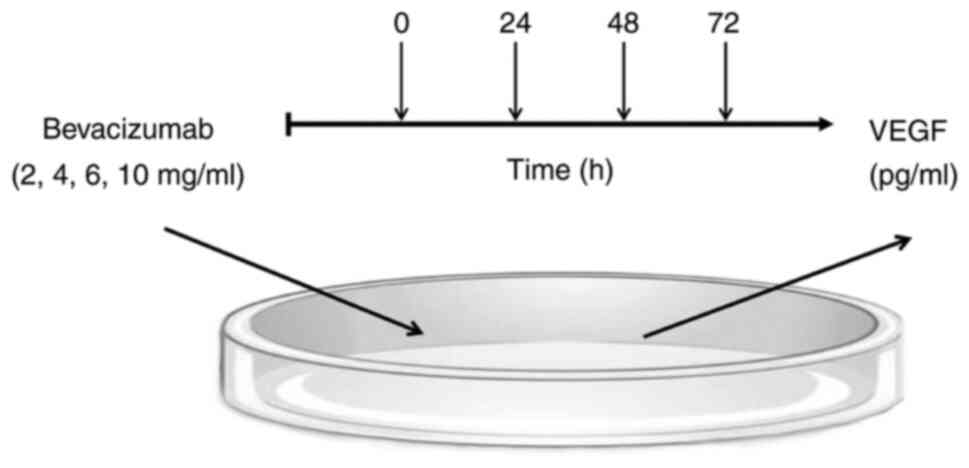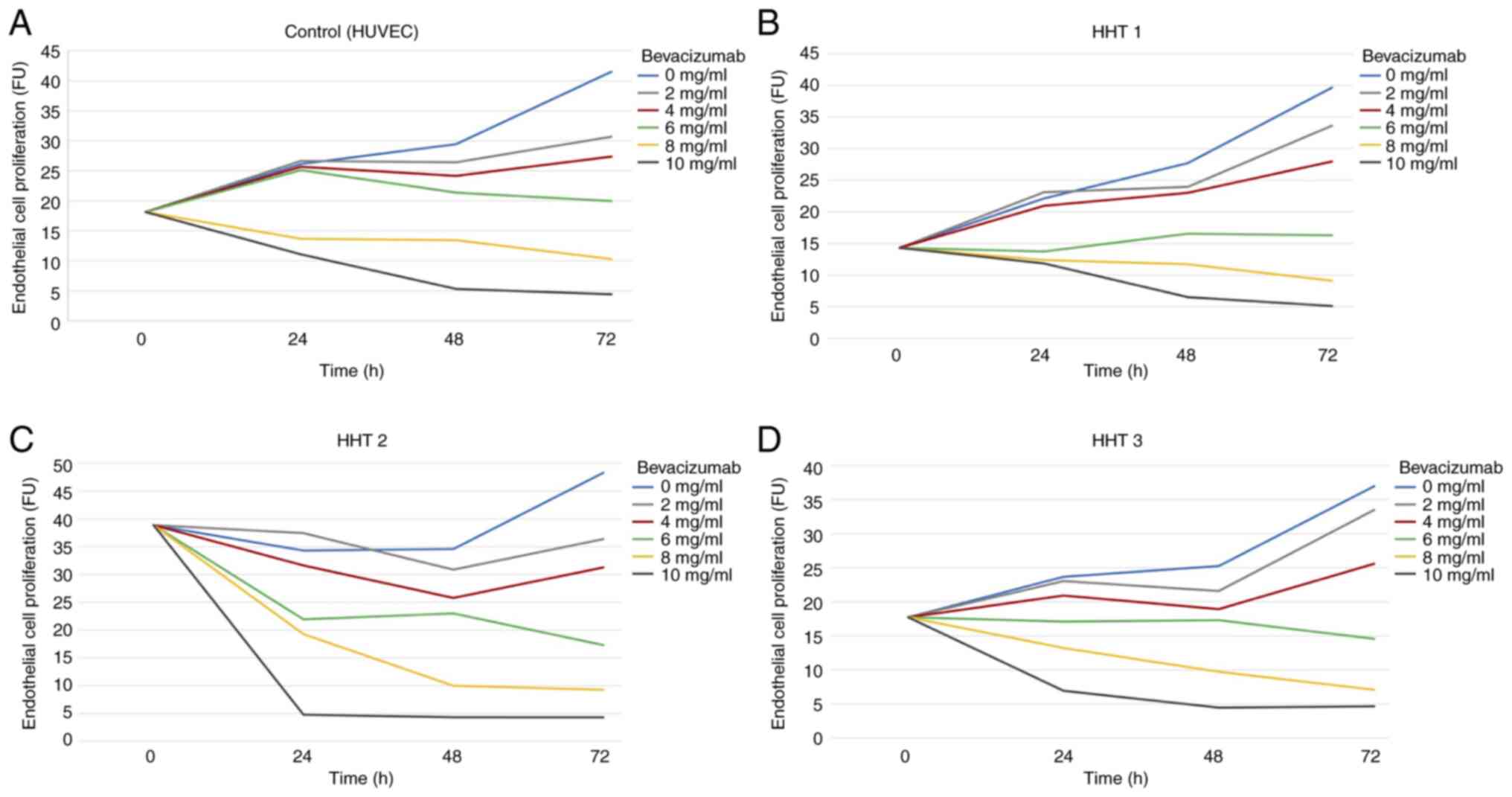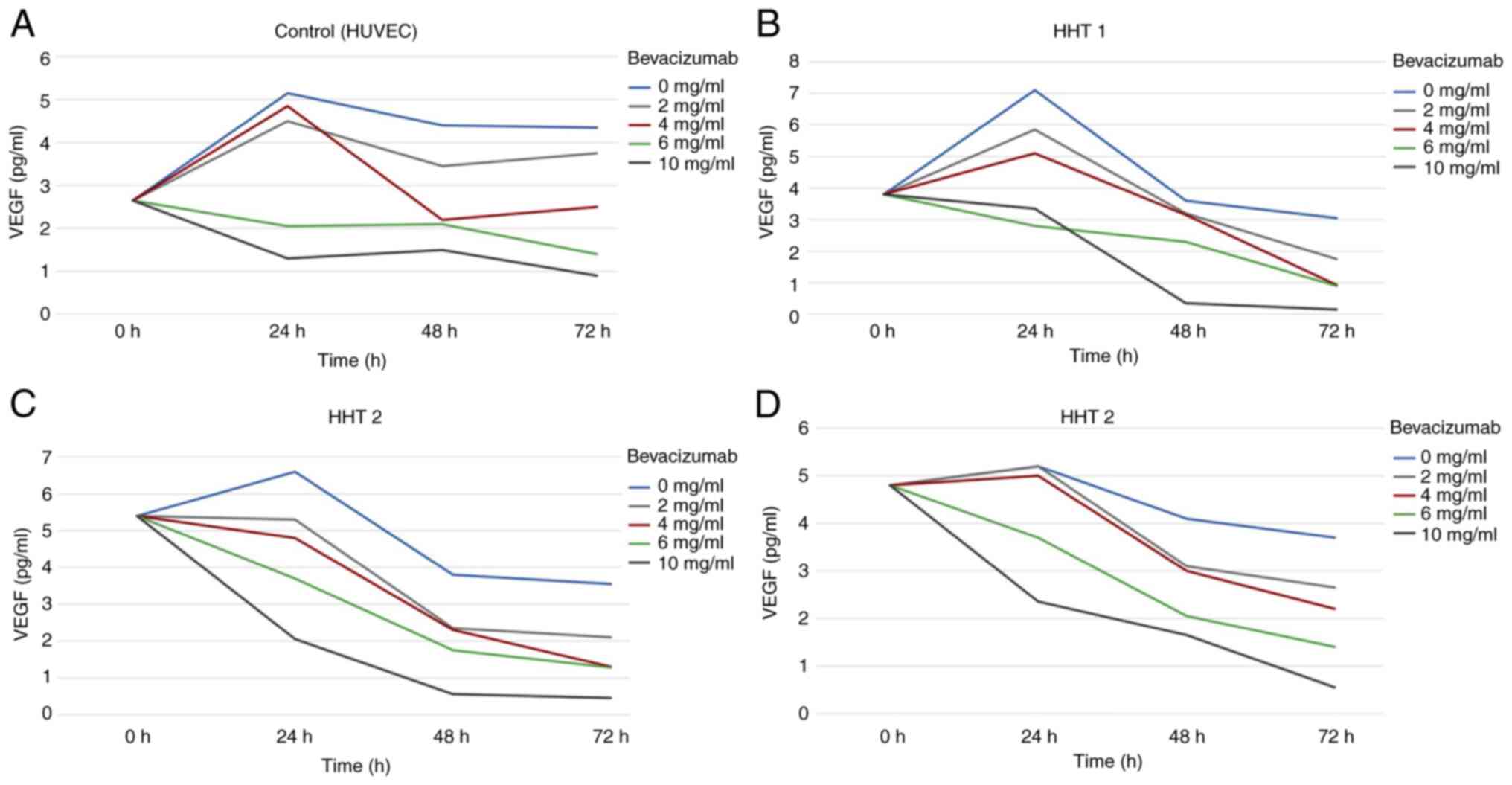|
1
|
Donaldson JW, McKeever TM, Hall IP,
Hubbard RB and Fogarty AW: The UK prevalence of hereditary
haemorrhagic telangiectasia and its association with sex,
socioeconomic status and region of residence: A population-based
study. Thorax. 69:161–167. 2014.PubMed/NCBI View Article : Google Scholar
|
|
2
|
Kjeldsen AD, Vase P and Green A:
Hereditary haemorrhagic telangiectasia: A population-based study of
prevalence and mortality in Danish patients. J Intern Med.
245:31–39. 1999.PubMed/NCBI View Article : Google Scholar
|
|
3
|
Sautter NB and Smith TL: Hereditary
hemorrhagic telangiectasia-related epistaxis: Innovations in
understanding and management. Int Forum Allergy Rhinol. 2:422–431.
2012.PubMed/NCBI View Article : Google Scholar
|
|
4
|
Plauchu H, de Chadarévian JP, Bideau A and
Robert JM: Age-related clinical profile of hereditary hemorrhagic
telangiectasia in an epidemiologically recruited population. Am J
Med Genet. 32:291–297. 1989.PubMed/NCBI View Article : Google Scholar
|
|
5
|
Ingrand I, Ingrand P, Gilbert-Dussardier
B, Defossez G, Jouhet V, Migeot V, Dufour X and Klossek JM: Altered
quality of life in Rendu-Osler-Weber disease related to recurrent
epistaxis. Rhinology. 49:155–162. 2011.PubMed/NCBI View Article : Google Scholar
|
|
6
|
Kritharis A, Al-Samkari H and Kuter DJ:
Hereditary hemorrhagic telangiectasia: diagnosis and management
from the hematologist's perspective. Haematologica. 103:1433–1443.
2018.PubMed/NCBI View Article : Google Scholar
|
|
7
|
Jakobsson L and van Meeteren LA:
Transforming growth factor β family members in regulation of
vascular function: in the light of vascular conditional knockouts.
Exp Cell Res. 319:1264–1270. 2013.PubMed/NCBI View Article : Google Scholar
|
|
8
|
Steineger J, Geirdal AØ, Osnes T, Heimdal
KR and Dheyauldeen S: Intranasal bevacizumab injections improve
quality of life in HHT patients. Laryngoscope. 130:E284–E288.
2020.PubMed/NCBI View Article : Google Scholar
|
|
9
|
Prigoda NL, Savas S, Abdalla SA, Piovesan
B, Rushlow D, Vandezande K, Zhang E, Ozcelik H, Gallie BL and
Letarte M: Hereditary haemorrhagic telangiectasia: Mutation
detection, test sensitivity and novel mutations. J Med Genet.
43:722–728. 2006.PubMed/NCBI View Article : Google Scholar
|
|
10
|
Oh SP, Seki T, Goss KA, Imamura T, Yi Y,
Donahoe PK, Li L, Miyazono K, ten Dijke P, Kim S and Li E: Activin
receptor-like kinase 1 modulates transforming growth factor-beta 1
signaling in the regulation of angiogenesis. Proc Natl Acad Sci
USA. 97:2626–2631. 2000.PubMed/NCBI View Article : Google Scholar
|
|
11
|
Sadick H, Hage J, Goessler U, Bran G,
Riedel F, Bugert P and Hoermann K: Does the genotype of HHT
patients with mutations of the ENG and ACVRL1 gene correlate to
different expression levels of the angiogenic factor VEGF? Int J
Mol Med. 22:575–580. 2008.PubMed/NCBI
|
|
12
|
Sadick H, Riedel F, Naim R, Goessler U,
Hörmann K, Hafner M and Lux A: Patients with hereditary hemorrhagic
telangiectasia have increased plasma levels of vascular endothelial
growth factor and transforming growth factor-beta1 as well as high
ALK1 tissue expression. Haematologica. 90:818–828. 2005.PubMed/NCBI
|
|
13
|
Sadick H, Naim R, Sadick M, Hörmann K and
Riedel F: Plasma level and tissue expression of angiogenic factors
in patients with hereditary hemorrhagic telangiectasia. Int J Mol
Med. 15:591–596. 2005.PubMed/NCBI
|
|
14
|
Han C, Choe SW, Kim YH, Acharya AP,
Keselowsky BG, Sorg BS, Lee YJ and Oh SP: VEGF neutralization can
prevent and normalize arteriovenous malformations in an animal
model for hereditary hemorrhagic telangiectasia 2. Angiogenesis.
17:823–830. 2014.PubMed/NCBI View Article : Google Scholar
|
|
15
|
Ferrara N, Hillan KJ and Novotny W:
Bevacizumab (Avastin), a humanized anti-VEGF monoclonal antibody
for cancer therapy. Biochem Biophys Res Commun. 333:328–335.
2005.PubMed/NCBI View Article : Google Scholar
|
|
16
|
Shih T and Lindley C: Bevacizumab: An
angiogenesis inhibitor for the treatment of solid malignancies.
Clin Ther. 28:1779–1802. 2006.PubMed/NCBI View Article : Google Scholar
|
|
17
|
Amarakoon S, Martinez-Ciriano JP, van den
Born LI, Baarsma S and Missotten T: Bevacizumab in age-related
macular degeneration: A randomized controlled trial on the effect
of on-demand therapy every 4 or 8 weeks. Acta Ophthalmol.
97:107–112. 2019.PubMed/NCBI View Article : Google Scholar
|
|
18
|
Iyer VN, Apala DR, Pannu BS, Kotecha A,
Brinjikji W, Leise MD, Kamath PS, Misra S, Begna KH, Cartin-Ceba R,
et al: Intravenous Bevacizumab for refractory hereditary
hemorrhagic telangiectasia-related epistaxis and gastrointestinal
bleeding. Mayo Clin Proc. 93:155–166. 2018.PubMed/NCBI View Article : Google Scholar
|
|
19
|
Andrejecsk JW, Hosman AE, Botella LM,
Shovlin CL, Arthur HM, Dupuis-Girod S, Buscarini E, Hughes CCW,
Lebrin F, Mummery CL, et al: Executive summary of the 12th HHT
international scientific conference. Angiogenesis. 21:169–181.
2018.PubMed/NCBI View Article : Google Scholar
|
|
20
|
Dupuis-Girod S: Anti-VEGF: A new
therapeutic option in hereditary hemorrhagic telangiectasia. Presse
Med. 42:385–387. 2013.PubMed/NCBI View Article : Google Scholar : (In French).
|
|
21
|
Cohen MH, Gootenberg J, Keegan P and
Pazdur R: FDA drug approval summary: Bevacizumab (Avastin) plus
Carboplatin and Paclitaxel as first-line treatment of
advanced/metastatic recurrent nonsquamous non-small cell lung
cancer. Oncologist. 12:713–718. 2007.PubMed/NCBI View Article : Google Scholar
|
|
22
|
Chen S IV, Karnezis T and Davidson TM:
Safety of intranasal Bevacizumab (Avastin) treatment in patients
with hereditary hemorrhagic telangiectasia-associated epistaxis.
Laryngoscope. 121:644–646. 2011.PubMed/NCBI View Article : Google Scholar
|
|
23
|
Stokes P and Rimmer J: Intranasal
bevacizumab in the treatment of HHT -related epistaxis: A
systematic review. Rhinology. 56:3–10. 2018.PubMed/NCBI View Article : Google Scholar
|
|
24
|
Simonds J, Miller F, Mandel J and Davidson
TM: The effect of bevacizumab (Avastin) treatment on epistaxis in
hereditary hemorrhagic telangiectasia. Laryngoscope. 119:988–992.
2009.PubMed/NCBI View Article : Google Scholar
|
|
25
|
Dupuis-Girod S, Ambrun A, Decullier E,
Fargeton AE, Roux A, Bréant V, Colombet B, Rivière S, Cartier C,
Lacombe P, et al: Effect of bevacizumab nasal spray on epistaxis
duration in hereditary hemorrhagic telangectasia: A randomized
clinical trial. JAMA. 316:934–942. 2016.PubMed/NCBI View Article : Google Scholar
|
|
26
|
Steineger J, Osnes T, Heimdal K and
Dheyauldeen S: Long-term experience with intranasal bevacizumab
therapy. Laryngoscope. 128:2237–2244. 2018.PubMed/NCBI View Article : Google Scholar
|
|
27
|
Riss D, Burian M, Wolf A, Kranebitter V,
Kaider A and Arnoldner C: Intranasal submucosal bevacizumab for
epistaxis in hereditary hemorrhagic telangiectasia: A double-blind,
randomized, placebo-controlled trial. Head Neck. 37:783–787.
2015.PubMed/NCBI View Article : Google Scholar
|
|
28
|
Rohrmeier C, Sachs HG and Kuehnel TS: . A
retrospective analysis of low dose, intranasal injected bevacizumab
(Avastin) in hereditary haemorrhagic telangiectasia. Eur Arch
Otorhinolaryngol. 269:531–536. 2012.PubMed/NCBI View Article : Google Scholar
|
|
29
|
Karnezis TT and Davidson TM: Efficacy of
intranasal Bevacizumab (Avastin) treatment in patients with
hereditary hemorrhagic telangiectasia-associated epistaxis.
Laryngoscope. 121:636–638. 2011.PubMed/NCBI View Article : Google Scholar
|
|
30
|
Karnezis TT and Davidson TM: Treatment of
hereditary hemorrhagic telangiectasia with submucosal and topical
bevacizumab therapy. Laryngoscope. 122:495–497. 2012.PubMed/NCBI View Article : Google Scholar
|
|
31
|
Lynch SS and Cheng CM: Bevacizumab for
neovascular ocular diseases. Ann Pharmacother. 41:614–625.
2007.PubMed/NCBI View Article : Google Scholar
|
|
32
|
Gordon MS, Margolin K, Talpaz M, Sledge GW
Jr, Holmgren E, Benjamin R, Stalter S, Shak S and Adelman D: Phase
I safety and pharmacokinetic study of recombinant human
anti-vascular endothelial growth factor in patients with advanced
cancer. J Clin Oncol. 19:843–850. 2001.PubMed/NCBI View Article : Google Scholar
|
|
33
|
Michels S: Is intravitreal bevacizumab
(Avastin) safe? Br J Ophthalmol. 90:1333–1334. 2006.PubMed/NCBI View Article : Google Scholar
|
|
34
|
Thompson AB, Ross DA, Berard P,
Figueroa-Bodine J, Livada N and Richer SL: Very low dose
bevacizumab for the treatment of epistaxis in patients with
hereditary hemorrhagic telangiectasia. Allergy Rhinol. 5:91–95.
2014.PubMed/NCBI View Article : Google Scholar
|
|
35
|
Färkkilä A, Pihlajoki M, Tauriala H,
Bützow R, Leminen A, Unkila-Kallio L, Heikinheimo M and Anttonen M:
Serum vascular endothelial growth factor A (VEGF) is elevated in
patients with ovarian granulosa cell tumor (GCT), and VEGF
inhibition by Bevacizumab induces apoptosis in GCT in vitro. J Clin
Endocrinol Metab. 96:E1973–E1981. 2011.PubMed/NCBI View Article : Google Scholar
|
|
36
|
Ramezani S, Vousooghi N, Kapourchali FR,
Hadjighasem M, Hayat P, Amini N and Joghataei MT: Rolipram
potentiates bevacizumab-induced cell death in human glioblastoma
stem-like cells. Life Sci. 173:11–19. 2017.PubMed/NCBI View Article : Google Scholar
|
|
37
|
Guilhem A, Fargeton AE, Simon AC, Duffau
P, Harle JR, Lavigne C, Carette MF, Bletry O, Kaminsky P, Leguy V,
et al: Intra-venous bevacizumab in hereditary hemorrhagic
telangiectasia (HHT): A retrospective study of 46 patients. PLoS
One. 12(e0188943)2017.PubMed/NCBI View Article : Google Scholar
|

















